F/A - 18 HORNET
 My
F-18 Hornet is a pusher that performs fantasticly. Top speed is about 90 mph. It is a fast and groovy flyer, yet
it slows down to a nose
My
F-18 Hornet is a pusher that performs fantasticly. Top speed is about 90 mph. It is a fast and groovy flyer, yet
it slows down to a nose  high walk when landing. It is fully aerobatic, capable of loops, rolls and inverted flight. This is
a fun fly airplane that stops traffic.
high walk when landing. It is fully aerobatic, capable of loops, rolls and inverted flight. This is
a fun fly airplane that stops traffic.
The foam core plug in wings have the spar slots, servo wells and servo
wire extension wire grooves already cut into the wing for you. The aircraft 5 ply retract plates are already installed
for the pneumatic style retracts such as Spring Air, Rhom Airs and Robart. The tail cone (turkey feathers) is fiberglass
and goes over the engine like a cowl would on a puller type aircraft. The inlets are vac. formed polystyrene and
the cockpit bubble is formed of tough PETG. The fire wall is precut from 1/4" aircraft ply and has 2 large
holes in it to allow the air that comes in from the inlets to flow over the engine.
The kit comes with a lot of hardware like the nose gear tandem wheel
"T" to solder onto your landing gear strut. It will fly off of grass with ease and  easily accepts a tuned pipe muffler inside the
fuselage with an elbow on the end to send the exhaust out the bottom between the inlets.
easily accepts a tuned pipe muffler inside the
fuselage with an elbow on the end to send the exhaust out the bottom between the inlets.
 A 14 oz. tank can be used behind the firewall
or the tank can be mounted on the C. G. and a pump can be used. If the tank is mounted behind the engine approximately
7 oz. of lead will be needed in the nose to balance the aircraft.
A 14 oz. tank can be used behind the firewall
or the tank can be mounted on the C. G. and a pump can be used. If the tank is mounted behind the engine approximately
7 oz. of lead will be needed in the nose to balance the aircraft.
Each aileron uses a servo mounted in the wing just foreword of the
ailerons. Wire and heat shrink tubing is supplied to make aileron servo extensions and they plug in where the wing
joins the fuselage. An Ace RC servo extension with a filter trap is used to go from the receiver to the aileron
plugs but we have found them not to be essential. The wing is cut with ample wash-out to make very stable straight
ahead soft stalls.
Our prototypes typically do not used rudders. This makes the plane
simple, however, we have found that they are needed only in cross wind landings and doing knife edges. Some pilots
have built their planes with rudders and they reported that they were not very effective. The fiberglass fuselage
is glass smooth and only needs to be scuff sanded and primered to be ready for any paint that you might want to
use. The wings can be monokoted or glassed with .60 oz. cloth. The inlets are fiberglass and the sidewinder rails
are vacuum formed.
| Wing span |
54" |
| Fuselage length |
68" |
| Weight |
10 lbs |
| Vertical fin height |
10-1/4" |
| Wing area |
900 sq. in |
| Radio |
5 channel
- 2 servos for the ailerons
- 1 servo for the nose wheel and rudders
- 1 servo for the retractabel landing gear
- 1 servo for the elevator
- 1 servo for the engine throttle
|
.
 My
F-18 Hornet is a pusher that performs fantasticly. Top speed is about 90 mph. It is a fast and groovy flyer, yet
it slows down to a nose
My
F-18 Hornet is a pusher that performs fantasticly. Top speed is about 90 mph. It is a fast and groovy flyer, yet
it slows down to a nose  high walk when landing. It is fully aerobatic, capable of loops, rolls and inverted flight. This is
a fun fly airplane that stops traffic.
high walk when landing. It is fully aerobatic, capable of loops, rolls and inverted flight. This is
a fun fly airplane that stops traffic.
